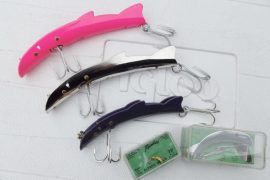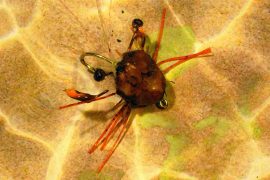
I got hooked on dredging while fly fishing a Miami roadside canal many moons ago. The canal in question was deep, and aside from holding the usual South Florida freshwater inhabitants, juvenile tarpon and snook from Biscayne Bay, or perhaps the Everglades, also worked their way there through a labyrinth of waterways.
While I occasionally hooked a tarpon on surface poppers at sunrise or sunset, it wasn’t until I stayed there later than usual one evening (it was winter and the skeeters weren’t bad) that I realized the canal came alive with rolling baby tarpon after dark. They were “fast rollers,” the kind that gulps air quickly and tail-kicks hard immediately after, as they head down deep. I took notice and figured, why not try a sinking line?

Armed with a 9-weight outfit, a Scientific Anglers Wet Cell fly line and an array of meaty flies, I returned the next evening and pointed a flashlight at the water. A half-dozen sets of of orange eyeballs shined, the baby tarpon were definitely there. So I positioned myself upstream of the fish, sent a bushy, black rabbit-strip Muddler sailing into the current coming from a nearby culvert and let it sink.
Just as the line got down-current of me, my fly got whacked hard. I set the hook firmly, and after a short burst, an acrobatic 20-pounder went airborne. For the next three hours, it was bedlam: a dozen tarpon hooked, three of which I landed, plus a pair of snook as a bonus.

DREDGING SCENARIOS
Since then, I have dredged with flies for striped bass in the Northeast, for snook at night in the St. Lucie River and Indian River Lagoon, tarpon under Florida Keys bridges, redfish under Florida Panhandle bridges, pompano over deep shell bars, seatrout and reds in a Louisiana marsh canal, and even for flounder around deep-water docks. And when done right, dredging doesn’t mean drudgery. Not only will you catch fish when surface presentations fail, but you’ll reach those that usually hold deep and also those forced by weather changes to go down and find water temperatures within their tolerance range. Dredging is deadly at night, too.
The technique calls for sinking fly lines, fishing weighted flies on a floating line isn’t true dredging. You can buy sinking lines in various sink rates, from an intermediate, the slowest (about 1.5 inches per second), through a Type 7, the fastest (sinks up to 8 inches per second). The head, approximately the line’s front 30 feet, weigh between 200 and 450 grain (there are 14 grains in a gram, so a 200-grain fly line weighs a half-ounce).
Shooting heads, lines about 30 feet long (essentially the weighted front part of a regular line) that you connect via interlocking loops to thinner running lines, are an alternative to full sinking lines. While shooting-head setups enable the fly angler to cast longer distances, I prefer full-length sinking lines,…





